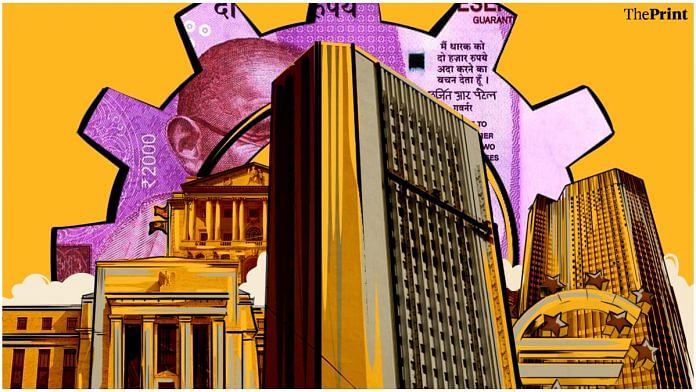Stock markets are in a turbulent phase currently, and this can be traced to global monetary policy changes. There is pressure on the rupee too after the US Federal Reserve indicated monetary policy normalisation.
Central banks in many of the major economies are normalising policy as prices have risen sharply over the last few months. The US Fed this month decided to quicken the pace at which it withdraws stimulus as inflation has risen to new highs.
Major central banks look to normalise policy
In November, the Fed had announced that it will reduce its pace of monthly bond purchases by $15 billion a month. The move this month to speed up the taper of bond purchases to $30 billion a month was in response to US CPI inflation, which surged to 6.8 per cent in November — the highest in 39 years.
The Fed also signaled its plan to raise interest rates thrice next year to cope with higher inflation. The decision is seen as a move to accelerate the reversal of the central bank’s expansionary monetary policy to support the US economy amid the Covid outbreak.
While the US has decided to withdraw stimulus earlier than anticipated, Britain became the first G7 economy to hike interest rates.
The Bank of England last week raised the policy rate from 0.1 per cent to 0.25 per cent as inflation is set to hit 6 per cent in April 2022 — three times its target level.
The European Central Bank (ECB) has decided on a step-by-step reduction in asset purchases starting the first quarter of 2022.
Even as the Omicron variant of the novel coronavirus poses a risk for global growth, central banks do not have the space to pursue eased monetary policy as globally inflation turns more entrenched.
More and more central banks are shifting their focus back to inflation even as growth recovery remains nascent. The minutes of the Reserve Bank of India’s meeting this month indicate that members of the Monetary Policy Committee (MPC) are also debating on the timing of policy normalisation as inflation becomes more broad-based.
Also read: Low rates are for short-term. RBI must raise rates to help household savings as inflation rises
Impact on India
Typically a signal to hike rates in the US triggers an outflow of foreign investments from emerging economies such as India as they tend to have higher inflation and interest rates than in developed countries.
Investors tend to take advantage of the interest rate differential by borrowing in the US at lower interest rates in dollar terms, and investing in the bonds of countries like India in rupee terms to earn a higher rate of interest. When the Fed raises rates, the interest rate differential between the two countries narrows, thus reducing the attractiveness of rupee denominated assets for foreign investors.
Tightening global liquidity conditions due to withdrawal of the stimulus would turn off the liquidity tap for emerging economies’ financial markets.
Eased financial conditions due to central banks’ bond purchases created excess liquidity which found its way in emerging economies’ stock markets. Now, the accelerated tapering of bond purchase could tighten liquidity and propel foreign fund outflows.
Overseas investors have been trimming their exposure in Indian equity and debt over the last two months. After recording net inflows in August and September, foreign investors turned net sellers in October and November.
Foreign fund outflows have intensified following the announcement of faster unwinding of monetary stimulus. The pace of selling by foreign investors in December has already exceeded that of October and November. Till 22 December, foreign investors have pulled out more than $3 billion dollars. Bulk of the selling is seen in equities. Foreign portfolio investment (FPI) flows are expected to remain volatile amid the rising Omicron cases and monetary tightening by advanced economies.
As higher US interest rates lure foreign investors, the dollar is expected to strengthen.
The volatility in markets is also expected to weigh on the rupee. Foreign fund outflows and uncertainty over the Omicron variant led to the rupee falling below the 76 per dollar level last week.
The RBI is estimated to have sold dollars to arrest the slide in the rupee. While currency volatility is expected to persist in the near term due to faster tapering by Fed, expectation of interest rate hikes and outflows by overseas investors, it is not likely to pose a concern over the medium term.
The announcement to quicken the taper was in line with market expectations. The Fed Chair had signaled even before the meeting that tapering could end sooner than anticipated as inflation is no longer transitory.
The RBI should avoid drastic policy responses to arrest the rupee slide. In 2013, the central bank tried to prevent rupee depreciation through monetary policy tightening and capital controls. The knee-jerk reactions were largely ineffective and made the depreciation sharper. The way forward is to focus on fundamentals and ensure macroeconomic stability.
Ila Patnaik is an economist and a professor at National Institute of Public Finance and Policy.
Radhika Pandey is a consultant at NIPFP.
Views are personal.
Also read: Omicron worries hit Indian economy just when it seemed poised to recover lost ground



